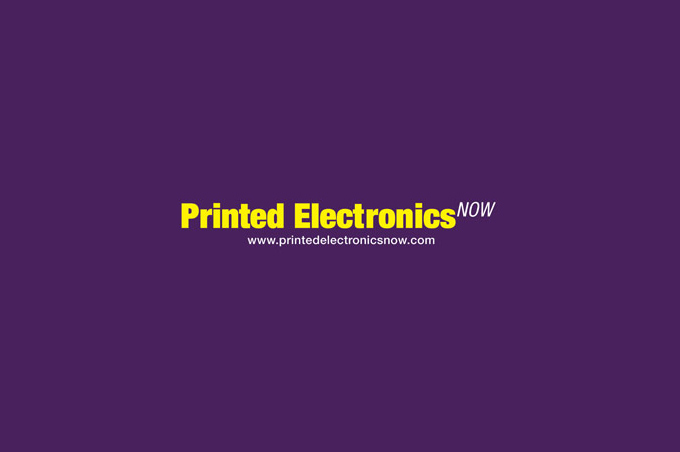The ability to print conductive ink is one of the major keys to the ultimate success of printed electronics. However, while there have been advances made in conductivity, dramatic increases in conductivity would improve the commercial potential of the technology.
To achieve dramatic changes in conductivity may require a revolutionary approach, and Dr. Richard McCullough and his colleagues at Carnegie Mellon University may have found the key by developing a form of liquid metal. The resulting spin-out, *Metalonix, which was incorporated last year, is already capturing the attention of PE industry leaders.
Dr. McCullough, Thomas Lord professor of chemistry at Carnegie Mellon University (CMU) and vice president of research at CMU, is a familiar name in the PE industry. As co-founder and chief scientist for Plextronics, Inc., Dr. McCullough helped develop polymer-based conductive inks that can be used with traditional printing processes, with applications in printed solar and displays.
For Metalonix, research in the underlying technology dates back to late 2007 at Carnegie Mellon University, when Dr. McCullough brought Dr. John Belot into his lab as a visiting professor in November 2007 to explore a technology to create liquid metals.
“In 2010, after the technology was well developed and test results were analyzed in comparison to current market offerings for metallic inks, it was discovered that we had a unique offering in the metallic ink market,” said Beth Vasy, operations manager for Metalonix, who was brought on a to drive the commercialization of the technology. “It was at this point that Dr. McCullough decided to turn the idea into a company.”
Metalonix’ technology is unique, as it offers a metallic ink that contains actual metal atoms. The competitive inks on the market contain either nanoparticles or metal flakes, neither of which are present in Metalonix inks. As a result, Metalonix’s inks act as a bulk metal, providing numerous benefits, including:
• High Conductivity: Metalonix inks convert to metal films that have conductivities comparable to the bulk metal and are two to three orders of magnitude more conductive than competitive metallic inks.
• Low Conversion Temperatures: Metallization temperatures of 100-150°C provide the opportunity to print on a variety of substrates including flexible plastic.
• Instantaneous Conversion Time: When a heating source of 100-150°C is applied, Metalonix ink converts to a metal within seconds.
• Ability to Print Small Precise Features: Not being limited by particle size (such as with nanoparticle inks), Metalonix inks can be deposited in small feature sizes.
• Fast Processing Speed Printing: With the ability to metalize instantaneously, Metalonix metallic inks can be deposited by various printing methods such as roll-to-roll and ink jet printing.
“Because we are on the atomic scale, our inks offer properties comparable to the bulk metal,” said Dr. McCullough. “While these functional and application attributes can be found in the metallic ink marketplace, Metalonix is the first to wrap them all into one package, making our metallic inks attractive to numerous end use markets.”
So far, the reaction from the PE community has been excellent. In June, Metalonix was announced as the winner of Most Promising Company and Best Presentation at LOPE-C 2011 Conference.
“We are honored to receive the award for Best Presentation from the OE-A at LOPE-C’s Investor Forum, in which 13 companies competed,” Dr. McCullough noted. “The competition was challenging, but it is rewarding that the judges not only felt we put together and delivered the best presentation, but also that our technology held the most promise for commercialization. This provides validation as we are currently raising a round of financing in order to further our commercialization efforts. We proudly display the trophy and framed award letter in our conference room to share our achievement with everyone who visits.”
Dr. McCullough believes that collaboration is critical for printed electronics, and is already seeing opportunities to bring Metalonix’ unique technology into various end-use markets.
“Collaboration across the value chain is key to advancing the printed electronics industry. Our business model is such that we plan to work with partners across the value chain in a number of markets to aid in furthering PE technology in general,” Dr. McCullough said. “While we are a material company, it is important that we achieve proof of concept in the markets we are looking to enter. By creating strategic corporate partnerships, we will be able to put our technology into working devices.
“We’ve had the opportunity to speak with numerous potential customers/partners in various markets, such as RFID, printed circuit board (PCB), OPV and printed memory, just to name a few, and we are pleased to report that we have received an overwhelming response to the data we’ve presented about our technology,” Dr. McCullough added. “We are working to explore further collaboration in these markets.”
Dr. McCullough said that the opportunities for Metalonix are widespread, as metal is found in virtually every electronic device.
“The most obvious applications for a metal ink manufacturer are within the printed electronic industry,” Dr. McCullough said. “As we are crafting our market entry roadmap, we’re exploring opportunities which are quick to market and also ones that offer a large market size. The key is that we fulfill the market’s biggest pain point, thus leading to a huge opportunity.
“Metal is in everything from electronics to medical devices,” Dr. McCullough added. “Starting at the time the alarm clock goes off in the morning, you come into contact with numerous devices that utilize metal in ways that Metalonix can provide better functionality through a more cost effective approach. Metalonix’s metallic ink’s ability to convert into a base metal at low temperatures coupled with its high conductivity levels provides traditional markets such as PCBs, transparent electrodes, and biomedical electrodes with an optimal solution. Emerging markets such as RFID, microchips and flexible displays benefit from Metalonix’s ability to be deposited onto a variety of substrates including organic and flexible at high processing speeds while providing precise relatively small features with high aspect ratios.
“While these are just a few examples of possible markets, there are endless possibilities to the uses of Metalonix’s metallic inks,” Dr. McCullough concluded.
*Metalonix is now Liquid X Printed Metals
By David Savastano, Editor | July 13, 2011
Read the full article: Printed Electronics NOW

